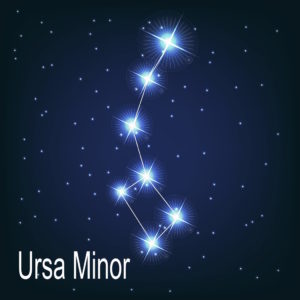
Let us give the child a vision of the universe…for all things are part of the universe and are connected to form one whole unity.
~Maria Montessori
A vision of the universe begins with looking up at the stars.
”The sky is the ultimate art gallery just above us,” wrote Ralph Waldo Emerson.
All we have to do is look up.
We help our children learn the names of animals from all over the world. Most three-year-olds can discern the difference between elephants and hippopotami. The stars, which we can see on any clear night, remain, for many of us, a nameless mystery.
My favorite book about the stars is Find the Constellations by H.A. Rey, famous for his Curious George series of books. Look for a 2007 or later version for an updated planet finder guide.
Rey does a wonderful job describing the constellations. His advice makes the major constellations easy to spot any time of the year using seasonal northern and southern sky view illustrations.
Rey describes stellar terms such as magnitude, light years and the star schedule with easy-to-understand language and entertaining drawings. Included in this book are the mythological stories of Andromeda and Orion that connect the constellations across the sky.
At 8:00 pm tonight, and 4 minutes earlier for the next two weeks, you should be able to step out and see the following constellations when looking north. For instance, tonight’s 8:00 sky will be visible at 7:00 pm on December 1.
Looking due north, the Little Dipper will be about halfway up the horizon appearing as if it were hung up by its handle. At the end of the handle is the bright star Polaris, also called the Pole Star or the North Star. By the way, the Little Dipper has an alias, the Little Bear, Ursa Minor.
The star Polaris appears to stand still in the sky while all the other stars circle it. The stars do not actually move around Polaris. Because of the rotation of the Earth, it only looks that way to us, as if the Pole Star was on a pole that the other stars are dancing around. Polaris always points north, thus its other name, the North Star. Look for the Little Dipper and the North Star to get your bearings in the night sky.
At this time tonight The Big Dipper will be low on the horizon looking as if the Little Dipper is pouring into the Big Dipper. Polaris, in the Little Dipper, lines up with the two outside stars in the bowl of the Big Dipper. The Big Dipper is technically a portion of the constellation of the Big Bear, Ursa Major, which can lead to some confusion as you look at star charts.
For your first viewing, the Little and Big Dippers may be all the challenge you want. Once you can locate the Little and Big Dippers it will be easy to find Draco the Dragon, Cepheus, Cassiopeia and Andromeda in the North Sky using a sky chart.
If you do want to look at another constellation on your first night out, turn and look due south. The Great Square will be about 70 degrees above the horizon. The Great Square is made up of four stars from the Pegasus and Andromeda constellations and is a landmark of the autumn sky.
After you locate The Great Square use a star chart to find Andromeda to the left (east) and Pegasus to your right (west).
Give your child a vision of the universe by stepping out and finding Polaris, the Pole Star, the star that the rest of the constellations dance around.
For we are all waltzing under an amazing work of art.
Sign up below for your free guide, What Should Our Children Learn?


Maren: Thank you so much for the information and time you take to make this avaliable.
Gloria,
You are so welcomed.